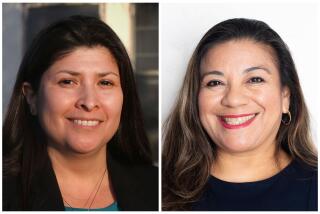One Year-Round School Plan Wins Rare Acceptance : Education: Schedule changes have not been as well-received elsewhere in the Santa Clarita Valley, where 5 districts struggle to absorb growing enrollments.
A strange thing happened when the Sulphur Springs school board voted this month to hold year-round classes at a crowded elementary school in Canyon Country.
No one showed up to complain.
A solution to crowded schools that in other districts has met bitter opposition, the decision to scrap traditional three-month summer vacations and switch to a year-round schedule at Pinetree Community School generated no controversy.
The scene was far different eight months earlier in the Newhall School District, just a few miles to the west. The Newhall school board, bowing to pressure from more than 100 angry parents who said their summer vacations would be ruined, scrapped plans to go year-round at one campus beginning this month.
The response to year-round schooling has been mixed in the Santa Clarita Valley, where five school districts--Saugus, Castaic, Newhall, Hart and Sulphur Springs--are struggling to absorb enrollments swollen by the region’s flood of new development.
Sulphur Springs administrators say additional schools might have to go year-round in the future. The idea is being studied by community advisory committees in the Castaic and Newhall districts. Saugus, for the moment, is not considering a switch to year-round schools to ease crowding and the superintendent of the Hart district, which serves the area’s high school students, has said a year-round schedule is not desirable at that level.
If the charging pace of growth continues and schools maintain their traditional schedules, district officials predict, they will have to build 33 schools by 2010--at a cost of $400 million.
Officials in the Sulphur Springs school district said they were able to sell parents on year-round schooling with a detailed, high-profile information campaign and by involving parents in the decision. District officials also reminded parents that the financially strapped state government already has a $6-billion backlog in requests for school construction money.
The lack of protest at the final hearing was a pleasant surprise, said Marc Winger, assistant superintendent of instructional services. It was a sign, he said, that the district had spread the word about year-round schools.
Other Santa Clarita Valley districts considering a switch to a year-round schedule hope to learn from Sulphur Springs’ example. Last Thursday, the trustees of the 1,300-student Castaic Union School District created a 20-member advisory committee to seek solutions to overcrowded schools, including year-round education. Castaic Supt. Scott Brown said Sulphur Springs provides almost a textbook example of how to approach the complex and potentially divisive issue.
School officials say year-round scheduling, technically known as “multitrack,” makes more efficient use of limited classroom space because students are divided into three or four staggered “tracks.” One track is always on vacation while the other tracks are in school--allowing, for example, 1,000 students to comfortably use a campus designed for 750.
A different form of year-round scheduling, where all students are on the same track, has been used for nearly 15 years in the Saugus Union School District. That program, however, is voluntary and is not an attempt to ease classroom crowding.
Starting next June, the Pinetree Community School will be the first school in the Santa Clarita Valley to operate on a multitrack schedule.
Sulphur Springs’ parents supported year-round schooling because district officials had already exhausted some other possible remedies and were still exploring others, Winger said.
For example, in an innovative plan to raise money for construction, the district recently agreed to lease some of its property to a developer who wants to build a shopping center. The trustees also may ask district voters this fall to approve bonds to build schools.
If growth continues, however, the Sulphur Springs district, with 3,200 students, may switch more of its seven campuses to year-round schedules, Winger said.
But if Sulphur Springs is a model of how to create support for year-round schools, the Newhall district is an example of how to drum up opposition.
The Newhall trustees voted in May, 1989, to start year-round classes at Meadows Elementary School this year, saying they would switch other schools to the schedule if enrollments continued to soar.
At last November’s public hearing, parents from other schools complained that they were left out. “Parents very strongly feel they were not involved in the process,” parent Brian Drygas told the school board.
The trustees said they included parents in the planning, but, recoiling under the criticism, agreed to delay implementing a year-round schedule at Meadows at least until July, 1992. The trustees also created a 40-member advisory committee to recommend other ways of relieving classroom crowding.
“They did a much better public relations job than we did,” acknowledged Supt. J. Michael McGrath, referring to the Sulphur Springs district.
The advisory committee is scheduled to present a list of short-term solutions to the trustees Tuesday. It will recommend that the district create a new school made entirely of portable classrooms until permanent schools can be built, said Frank McKendall, who chaired the advisory committee.
The committee also will recommend the creation of a single magnet school that would operate on a multitrack schedule. The school would offer specialized programs, such as science or arts, to entice parents into volunteering to enroll their children.
The committee will make long-term recommendations to the Newhall trustees in September.
“Unless we get funding from the state, I think it’s inevitable,” McGrath said of a switch to year-round schools. “And I think it’s not just for us, but for everyone.”
More to Read
Sign up for Essential California
The most important California stories and recommendations in your inbox every morning.
You may occasionally receive promotional content from the Los Angeles Times.










